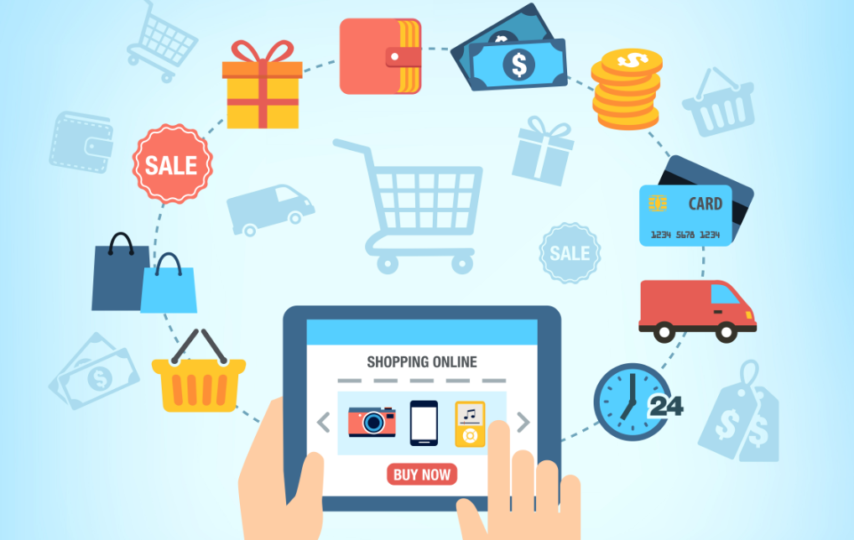The invitation to the digital marketplace of the 21st century is right at your fingertips, where one click will let you be in a world that is full of products and services in line with your desires. Think you are wandering down an astonishingly busy virtual street where every shop there has so many goods to see and investigate.
This is what web&store is all about; a modern online platform that connects online businesses to consumers in order to provide the best shopping experience through the boundless web and accomplish their online transactions easily and more smoothly. It is our pleasure to explore together the compelling world of web stores, getting deep into their secrets, benefits, and endless chance for both buyers & sellers that they present.
What is Web&store?
Image Credit – Pinterest
A web&store functions as a digital marketplace, offering businesses a platform to showcase their products or services & facilitate transactions online. Serving as a virtual storefront, it allows customers to browse, purchase, & interact with brands from anywhere with internet access.
This model provides convenience & accessibility, enabling businesses to expand their reach beyond physical locations & offering consumers the flexibility to shop at their own convenience. Through features like inventory management, payment processing, & customer support, web stores play a pivotal role in the modern e-commerce landscape, driving sales & fostering brand engagement in the digital sphere.
How to Setup a Web Store Online?
Here’s a more detailed breakdown of steps involved in setting up a web&store:
1. Market Research: Begin by conducting thorough market research to identify your target audience, understand their needs, preferences, & purchasing behavior. Analyze your competitors to discern gaps in the market & opportunities for differentiation.
2. Define Your Goals: Clearly outline your business objectives & goals for the web store. Determine what you aim to achieve, whether it’s increasing sales, expanding your customer base, or enhancing brand awareness.
3. Choose a Business Model: Decide on the type of business model you’ll adopt, whether it’s dropshipping, inventory-based, subscription-based, or a combination of these. Choose a model that aligns with your resources, capabilities, & long-term vision.
4. Select an E-commerce Platform: Research & select a suitable e-commerce platform that meets your business requirements. Consider factors such as ease of use, customization options, scalability, integrations, & pricing. Popular platforms include Shopify, WooCommerce, Magento, & BigCommerce.
5. Register a Domain Name: Choose a memorable & relevant domain name for your web store. Ensure it reflects your brand identity & is easy to spell & remember. Register the domain through a domain registrar.
6. Secure Web Hosting: Choose a web hosting company which is reliable and will host the website. You may also account for factors such as; high level of uptime, speed, security features, quality customer support and scalability. A hosting plan should be selected which can handle the traffic hat is projected & at the same time, should also be in accordance with your site needs.
7. Website Design & Development: Implment web store, lay a lot of emphasis on the design, intuitivity, & mobile-friendly nature of it. Elaborate into individual identifiers like suits, pages, colour palette, and language of writing your brand.
8. Product Selection & Sourcing: Choose the brand that will have an online store display. Use the same database including inventor’s of suppliers, manufacturers, wholesale or dropshipping. An extensive product range that is a fine example of your potential in meeting your target audience should be a part of your portfolio.
9. Product Listing & Descriptions: Publish the product listings with clear pictures, well written descriptions, property features, prices and an overview of the sellers terms & conditions. Search engine optimized pages of product will lead visibility and organic traffic on the site as well.
10. Set Up Payment Gateways: The integration of secure payment made possible by the use online of the payment gateway you will able to transact. Pick up cash registers from a reliable payment processing provider that accept many types of payments and offer safe transaction services. Pick tax options, shipping communications, & currency selection.
11. Implement Security Measures: Set up the state of art security systems to protect customer data, prevent fraud and authentication of the monetary transactions. Ensure SSL certificates installed, HTTPS encryption enabled, & comply with PCI-DSS by advising customers about their data security.
12. Test & Launch: Undertake the comprehensive testing of your online platform while detecting and tracing the bugs & errors as well as solving the inconvenient usability issues. Give the website’s performance a test run, checking whether its navigation, checkout process, and cross-browser/ink-browser compatibility is okay. As soon as your inventory reaches its final stages, go public with your online store launch.
13. Promote & Market: Creating an all-round marketing approach for the flawless selling and marketing of the web store. Published multiple marketing channels including using of social media prospecting, e-mail marketing, SEO- search engine optimization, content marketing, influencer partnerships, and paid advertising to improve your visibility and attract a customer. Keep evaluating the numbers through different key performance indicators and adapt your marketing strategies based on this insights to enhance the results and to hunt for the ultimate success.
Frequently Asked Questions
Here are some frequently asked questions about web&store:
1. Q: What is a web store?
- A: A web store is an online platform where businesses showcase products/services & conduct transactions over the internet.
2. Q: How do customers interact with a web store?
- A: Customers browse, purchase, & engage with brands through the web store’s digital interface.
3. Q: What are some popular e-commerce platforms?
- A: Shopify, WooCommerce, Magento, & BigCommerce are popular e-commerce platforms.
4. Q: Why is market research important before setting up a web store?
- A: Market research helps understand the target audience, competition, & market trends to tailor the web store effectively.
5. Q: What should businesses consider when choosing a web hosting provider?
- A: Businesses should consider factors like uptime, speed, security features, customer support, & scalability when choosing a web hosting provider.
Conclusion
With the end of the current article, it becomes clear that online stores are the major part of the revolutionizing process of the past years, how we shop & do business distinguishes it self in the world. From as simple as sitting at home to obtain the information any person wants, to the global reach they afford businesses, web stores are the latest technology & commerce connection, allowing both consumers & entrepreneurs the chance to have a shot to be something.
While we contemplate the future, it is evident that the web stores’ evolution will certainly have a great impact on the e-business sector that provides more space for new discoveries and advancements. Thus, whether you are either a prudent shopper in search of the new trend or an ambitious entrepreneur who needs to reach more customers, the internet of news offies is open for you as boundless opportunities. Cheers to a great shopping experience, and always keep your digital ventures challenged with excitement and success!







